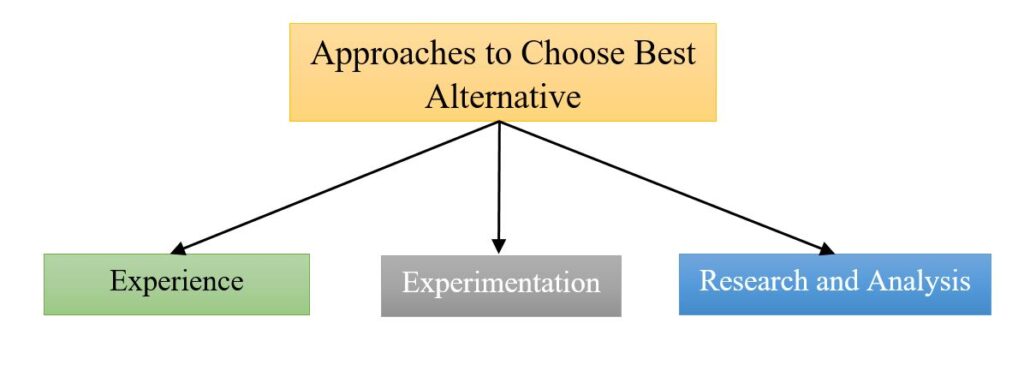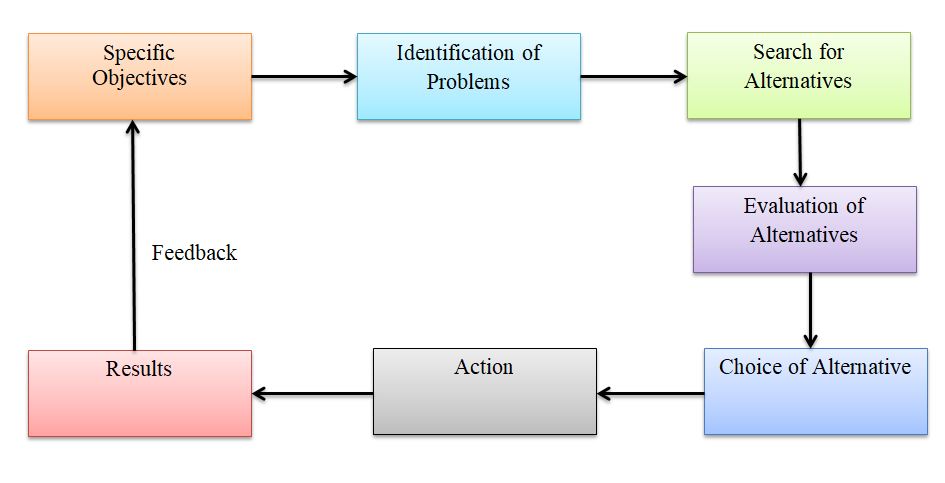Decision making process
1. Specific objectives
Rational decision making involves a concrete goal of objectives. So the first step in decision-making is to know one’s objectives.
An objective is an expected outcome of future actions. So before deciding upon the future course of efforts, it is necessary to know beforehand what we are trying to achieve. Exact knowledge of goals and objectives bring purpose in planning and harmony in efforts. Moreover, objectives are the criteria by which final outcome is to be measured.
2. Problem identification
Since a particular decision is made in the context of certain given objectives, identification of problem is the real beginning of decision problem is a felt need, a question thrown forward for solution. It is the gap between present and desired state of affairs on the subject-matter of decision. The objectives if set precisely and specifically on the subject matter of decision, will provide clue in identifying the problem and its possible solution. Further, in management, a problem exists whenever one faces a question whose answer involves doubt and uncertainty. If there is no solution to the problem, it cannot be treated as problem form decision point of view, though the consequences of not solving this problem may be terrible. A problem can be identified much clearly, if managers go through diagnosis and analysis of the problem.
i. Diagnosis
Accurate diagnosis of a problem is as essential for a manager as knowing the correct disease is for a doctor. Often managers fall to diagnose the problem correctly and sometimes they treat symptom as problem. A symptom is a condition or set of conditions that indicates the existence of a problem. For example if an organization has high turnover of its employees, it indicates that something is wrong with the organisation. The symptom of high turnover may provide the clue to the real problem and managers can overcome the problem by talking appropriate action. Often managers fall to diagnose the problem correctly and sometimes they treat symptoms as problem. Therefore, they should do this exercise very carefully. Diagnosing the real problem implies knowing the gap between what is and what ought to be, identifying the reasons for the gap, and understanding the problem in relation to higher objectives of the organization.
ii. Analysis
While diagnosis of problem gives the understanding of what should be done in terms of decision making, analysis of problem takes it a step further. The analysis of the problem requires to find out
(a) Who would make decision?
(b) What information would be needed?
(c) From where the information is available?
This analysis may provide managers with revealing circumstances that help them to gain an insight into the problem. the whole approach of analyses of problem should, however be based around critical factors like the availability of information for making decision, criticality of decision, and the time available for making decision.
Diagnosis and analysis of problem requiring decision will clarify what is needed and where the alternatives for doing the thing can be sought.
3. Search for alternatives
A thorough diagnosis defines both a specific problem and the situation in which the problem exists. With this definition in mind, a decision maker seeks possible solutions. A problem can be solved in several ways, however, all the ways cannot be equally satisfying. Further, if there is only one way of solving a problem, no question of decision arises. Therefore, the decision maker must try to find out the various alternatives available in order to get the most satisfactory result of a decision. Identification of various alternatives not only serves the purpose of selecting the most satisfactory one, but it also avoids bottlenecks in operation as alternatives are available if a particular decision goes wrong.
4. Evaluation of alternatives
After the various alternatives are identified, the next step is to evaluate them and select the one that will meet the choice criteria. All alternatives available for decision making will not be taken for detailed evaluation because of the obvious limitations of managers in evaluating all alternatives. The energy of managers is limited and psychologically most of them prefer to work on plans that have good prospect of being carried out. In narrowing down the number of alternatives various approaches can be used. Peter Drucker has pointed out four criteria for selecting the best alternative-the risk involved, cost and economy, timing and urgency and lastly limitations of resources.
5. Choice of alternatives
After evaluation of various alternatives, the next step is the selection of the best solution. It requires an ability to draw distinction between seen and unseen forces, between tangible and intangible and intangible forces between facts and guesses. In attempting to select from alternatives, several basic approaches of decision-making are open to the manager.
i. Experience
Managers can choose an alternative based on their past experience if they have solved similar problems earlier. Managers rely more on experience than alternative methods of choice. Past experience has some benefits but it has certain limitations that it blocks making correct choice specially when the environmental factors are more flexible.
ii. Experimentation
Experimentation which is generally used in scientific enquiry involves that a particular alternative is put in practice, result is observed, and the alternative giving the best result is selected. For example, many organizations before launching the product on large scale in the wider market, first go for test marketing of their products, where they introduce the product in small market. During test marketing the actions can be taken to change product features which are not acceptable. Experimentation as a method for choice of an alternative can be used on a limited scale because of cost and time factor.
iii. Research and analysis
Research and analysis is the most certain method of selecting an alternative, specially when major decisions are involved. This approach entails solving a problem first by comprehending it. It involves a search for relationship between the more critical variables, constraints and planning premises that bear the objective sought. In the second stage, the alternative is broken into various components. Their individual impact on objective is evaluated and the impact of all factors of an alternative is combines to find out the total impact of the particular alternative. The one having the most positive impact is chosen. Since this requires making a lot of calculations, often the help of computer is taken, in fact, various computer based models have been developed to make the choice of an alternative easier.
Though various approaches are available for choosing an alternative, the decision maker’s personal values and aspirations affect what alternative will be choosing. Thus, the rational process of decision making is considerably affected by personal factors.
6. Action
Once the alternative is selected, it is put into action. Implementation of a decision requires the communication of decisions to the subordinates in clear and unambiguous terms. Further effort should be made to secure employee’s acceptance of the decision. If there is opposition or resistance on the part of the employees, steps should be taken to win their cooperation. It is desirable to associate employees in some stage of the decision-making process, so that the whole-hearted participation from their side can be secured. As all decisions affect the employees and their work, it is desirable that they should be associated with the decision making process. moreover, the association of employees in the decision making process can help improve the equality of the final decision by revealing points which may have been overlooked by the manager and uncovering obstacle in the way of its execution.
The decision should be implemented at appropriate time and in proper way to make the action more effective. the effectiveness of action is important because it is only effective action through which organizational objectives can be achieved and right decisions help in effective action.
7. Results
When the decision is put into action, it brings certain results. These results must correspond with objectives, the starting point of decision process, if good decision has been made and implemented properly. Thus, results provide indication whether decision and its implementation is proper. Therefore, managers should take up a follow-up action in the light of feedback received from the results. If there is any deviation between objectives and results, this should be analyzed and factors responsible for this deviation should be located. The feedback may also help in reviewing the decision when conditions change which may require changes in decision. Therefore, a successful manager is one who keeps close look at the objectives and results of the decision and modifies his decision according to the changes in their circumstances.



